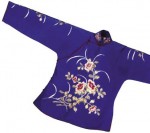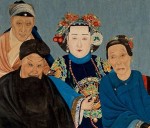Anhui Troupes and the Birth of Peking Opera
 Rulers of the Qing Dynasty (1644-1911) all liked operas. Some of them, such as Empress Dowager Cixi (1835-1908), were connoisseurs of Peking Opera. At the end of the 18th century, operatic singing in China had developed into several systems. Popular local operas used tunes that included gaoqiang (pitched singing), geyang (prevalent along the middle and lower reaches of the Yangtze), bangzi (prevalent along the Yellow River valley) and liuzi (which originated in Shandong). To literati at the time, these operas were far inferior to kunqu opera, which is refined and serious. With much disdain, they called these local operas huabu.
Rulers of the Qing Dynasty (1644-1911) all liked operas. Some of them, such as Empress Dowager Cixi (1835-1908), were connoisseurs of Peking Opera. At the end of the 18th century, operatic singing in China had developed into several systems. Popular local operas used tunes that included gaoqiang (pitched singing), geyang (prevalent along the middle and lower reaches of the Yangtze), bangzi (prevalent along the Yellow River valley) and liuzi (which originated in Shandong). To literati at the time, these operas were far inferior to kunqu opera, which is refined and serious. With much disdain, they called these local operas huabu.
The popularity of huabu had something to do with its popular appeal. Huabu plays tell historical stories or folk tales loved by the laboring people. Singing was lucid, lively and intense, and recitations were easy to understand. The ugly ducklings became so popular that many huabu companies competed for turf even in Suzhou, Jiangsu Province, the birthplace of kunqu opera.
Peking Opera has its origin in huabu operas. It was not born in Be?ing (Peking). Its predecessor was a huabu opera that was prevalent in the middle and lower reaches of the Yangtze performed by Anhui troupes in the mid-17th century. Anhui troupes had not been limited to staging Anhui huabu opera. They also performed kunqu opera, Hubei’s hanxi opera and the central plain’s bangzi opera. As a result, these troupes had rich and colorful tunes as well as a wide range of interesting plays. Their actors had developed feats and stunts. Before coming to Beijing, the Auhui huabu opera combined the characteristics of tunes of er huang and xi pi, the former is steady and melancholy, the latter is brisk and lively, er huang and xi pi constitute the core of the tune of Peking Opera. In addition, the Anhui troupes were good at assimilating the performing characteristics of other operas, such as the recitation of jingqiang opera (Peking), the high-pitched arias of qinqiang opera (Shaanxi), the tunes and recitation of hanxi opera (Hubei), and the bodily movements, ways of portrayal and music of kunqu opera (Suzhou). After sixty years of evolution, a unique theatrical variety – Peking Opera – came into being.
In 1790, an Anhui troupe headed by Gao Langting came to Be?ing to participate in performances in celebration of the 80th birthday of Emperor Qianlong. It was soon followed by three other theatrical companies from Anhui – Sixi, Chuntai and Hechun. After doing their job, these Anhui troupes stayed in the capital to offer performances to the local public. By this time, what the Anhui troupes were offering was Peking Opera.
Peking Opera, which had been developed from an assortment of rural shows, had a wide range of audiences. They included not only members of the royal family, officials and scholars, but also merchants, townspeople and handicraftsmen. Peking Opera gradually became a townspeople-oriented performing art. The Qing Dynasty was in a period of social stability and economic prosperity when the Anhui troupes brought Peking Opera to the capital city. At the turn of the 19- 20th centuries when Peking Opera had come to maturity, Be?ing had a thriving handicraft industry and commerce; it was home to some 360 guild houses; and service industries catering to the townspeople were also thriving. At the time, the Qianmen area was not only a commercial center but also had a concentration of theaters, teahouses and restaurants; and the Tianqiao and Bell Tower areas swarmed with street performers as well as peddlers and small traders. These not only provided sources of audience for performances in the theaters but also brought new management methods for the theaters and Peking Opera companies.
After 1860, with mobile performances by opera companies, Peking Opera quickly spread all over the country. Tianjin and the surrounding Hebei and Shandong provinces were where Peking Opera gained popularity at an early date. Areas with a fairly early arrival of Peking Opera included Anhui, Hubei and northeast China. In 1867, Peking Opera spread to Shanghai. At the time, a number of well-known Peking Opera actors went south, making Shanghai a Peking Opera center on a par with Beijing. Peking Opera in Shanghai gradually developed some unique characteristics, leading later to the division of “Beijing School” and “Shanghai School.” By the beginning of the 20th century, Peking Opera was performed in Fujian and Guangdong in the south, Zhejiang in the east, Heilongjiang in the north and Yunnan in the southwest. In the 1940s, Peking Opera had impressive development in Sichuan, Shaanxi, Guizhou and Guangxi.
Portraits of Peking Opera characters played by famous actors of late Qing Dynasty, painted by Shen Rongpu, a well-known portraitist active in the late Qing period.In 1919, Mei Lanfang, a Peking Opera master actor enjoying unrivalled fame then and even today, went to Japan with his theatrical company to stage performances. Peking Opera troupes have since frequently staged performances in foreign countries. And people in the rest of the world regard Peking Opera as the representative of the traditional Chinese theater. Today, Peking Opera has become the premier opera type in China having no rival in terms of the number of plays, performing artists, troupes and audiences as well as influence.